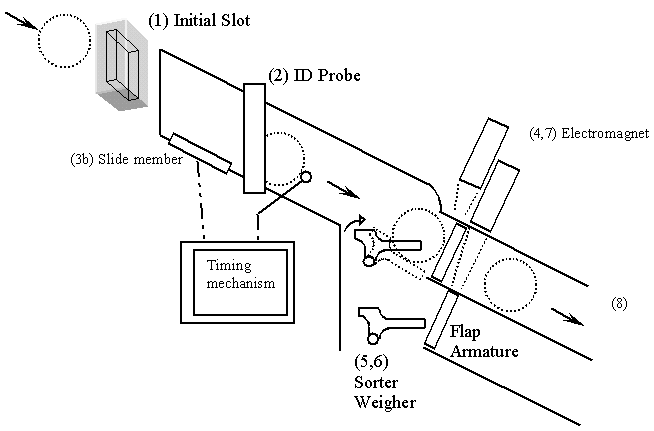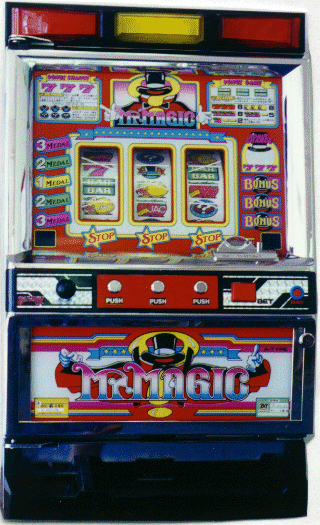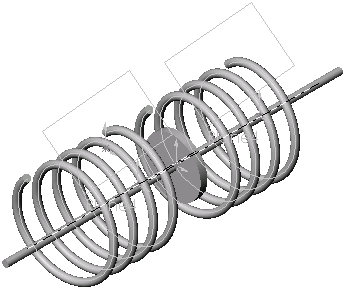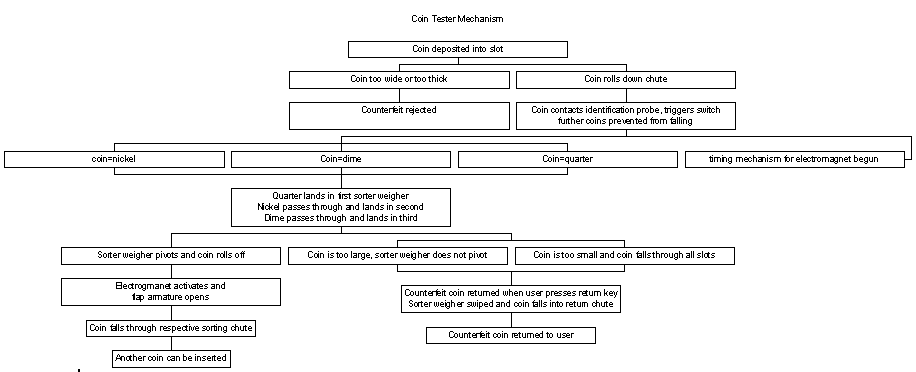 |
 |
| HOW A COINT TESTER WORKS | ||
| QUESTIONS OR COMMENTS | ||
 |
AUTHOR: | David Hu |
| E-MAIL: | dhu@mit.edu | |
| COURSE: | 2 | |
| CLASS/YEAR: | 2 | |
MAIN FUNCTIONAL REQUIREMENT: Test different denominations of coins and reject counterfeit ones while accepting correct coins to be sorted and counted
DESIGN PARAMETER: Coin Tester
GEOMETRY/STRUCTURE:
 |
| Figure 1: Coin Testing Apparatus Schematic |
Center: coin to be identified; |
| Figure 2: Electric Identification Probe |
EXPLANATION OF HOW IT WORKS/ IS USED:
1. User deposits coin into coin slot on outside of machine. Coin slot is dimensioned to
the width and height for the thickest and largest diameter coin to be accepted.
2. Coin rolls down a chute and past identification probe that determines the denomination
by the coin’s material properties. The probe consists of two solenoids with
their axis perpendicular to the longitudinal wall of the chute. Current is run
through one solenoid which then generates a B field perpendicular to the coin axis of revoluion. The magnetic field passes through the
coin, is attenuated by the coin's material properties and geometry before being received
by the solenoid at the opposite end. The B field passing along the axis of
the second coil generates a specific pattern of electric current, which can be matched
with the correct coin.
3. a) Coin also activates switch that b) pulls slide member toward wall of chute (into
page) by means of electromagnet, thereby preventing another coin from entering.
4. The probe sends information to timing mechanism for turning on of electromagnetic
device that opens flap armature.
5. Coin falls down chute and onto first sorting weigher. The number of denominations to be
accepted determines the number of sorting weighers (e.g. quarter,dime,nickel =3 weighers).
Each sorting weigher is pivoted and contains a slot dimensioned to diameter of specific
coin. The sorting weighers are arranged by size of coin to be accepted, with the largest
coin size weigher on top. The left arm of the sorter weigher holds a counterweight that
will be lifted only if the coin is the correct weight.
6. Sorting weigher pivots under the weight of coin and coin rolls toward chute.
7. Electromagnet turns on and the coin’s specific flap armature opens momentarily
allowing coin to fall through chute.
8. Coin rolls down chute to be sorted.
DOMINANT PHYSICS:
tI=time to i event
Opening of Flap armature: ttotal = tcoin + tarmature
tcoin = time
for specific coin to roll from probe chute onto sorting weigher + time for sorting weigher
to pivot and coin to roll off sorting weigher
tarmature =
time for armature to rise enough for coin to continue down chute
LIMITING PHYSICS:
The performance/use of the machine is limited by the position of the machine. If the machine is not seated on a level plane, then the coin will take longer to roll down the chute and the timing mechanism will open the flap armature before the coin can pass through.
PLOTS/GRAPHS/TABLES:
|
| Figure 3: Detection of Counterfeit Coins |
WHERE TO FIND COINT TESTERS:
This design for the coin tester limits it to places where either electricity can by obtained or a battery connected. Coin testers have few moving parts and simple circuitry, making them inexpensive to manufacture. They are in most vending machines and slot machines where counterfeit coins need to be detected.

REFERENCES/MORE INFORMATION:
Prumm, Georg J. "Electronic Coin Tester with Controlled Mechanical Testing Device." US patent 4,234,072. Nov 19, 1980.
Parker, Donald and Rollins, Robert. "Coil configuration for electronic coin tester and method of making."US Patent 4,905,814. March 6, 1990

